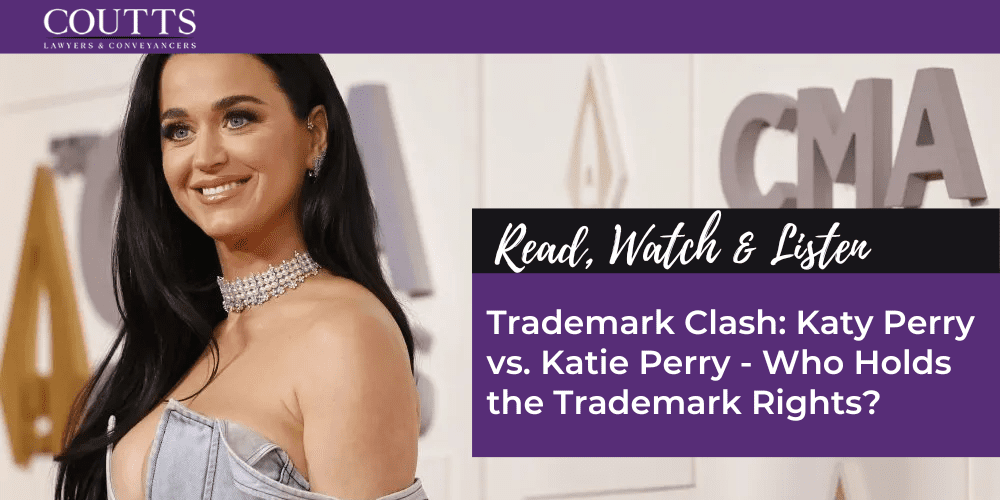KEY TAKE-OUTS:
- Australian fashion designer, Katie Taylor has won an ongoing court battle against American pop star Katy Perry.
- Katie Taylor with the maiden name Perry, sued the pop star for allegedly infringing her trade mark “Katie Perry.”
- This case emphasises the importance of registering your trade mark to prevent a third-party infringement.
History of the case
A legal action was initiated in June 2009 over a trade mark held by Katie Jane Taylor. Katie Taylor established her business under the brand name “Katie Perry” to design and sell clothes. Katie Taylor has registered a trade mark for “Katie Perry” in class 25 for clothing while Katheryn Hudson (who takes the stage name Katy Perry) has a registered trade mark for “Katy Perry” in class 3 for perfumes and cosmetics, class 9 for music recordings and class 42 for entertainment and live music services. The fashion designer and pop star have been in dispute over who has the right and benefit to the name.
Federal Court
In 2019, through Litigation Capital Management (LCM), a global litigation funder decided to fund Ms Taylor’s case against the pop star and proceedings were initiated in the Federal Court of Australia. The plaintiff, Ms Taylor had commenced proceedings against Ms Hudson and her companies Killer Queen and Kitty Purry. Ms Taylor claimed that the pop star had infringed her trade mark pursuant to s 120 of the Trade Marks Act 1995. Section 120 of the Trade Marks Act 1995, states that a person infringes a trade mark if they use a trade mark that is “substantially identical with or deceptively similar to the trade mark.”
Defence
The pop star defended the claim made by Ms Taylor and filed a cross-claim seeking orders that the trade mark be cancelled on the basis that the singer already had a reputation in Australia, before Ms Taylor’s trade mark. Following the hearing, the court held that the pop star’s success in the entertainment and music sector was not relevant to the fashion industry and also disagreed that due to the singer’s reputation, it would likely deceive or cause confusion to consumers that the singer was associated with Ms Taylor’s brand.
The pop star argued the “good faith” defence under section 122(1)(a)(i) Trade Marks Act 1995 (Cth). The “good faith” defence is available to a party against trademark infringement where in good faith:
- Use a name, place of business or predecessor;
- Use a sign to indicate a characteristic of goods or services; or
- Use the trade mark to indicate the intended purpose of the goods or services they are providing.
The court held that the pop star did not have to compensate the designer personally, as she was successful in her “good faith” defence. However, Ms Hudson’s company Kitty Purry was found to have infringed the trade mark. Kitty Purry was found liable for the sale of clothing during the 2014 tour, pop-up stores and on the Bravado website. The singer’s company Kitty Purry was ordered to pay damages to Ms Taylor, which amount is yet to be determined by the Court.
What is a Trade Mark and how to protect yourself?
This case highlights the importance of protecting your brand and registering your trade mark. A person who owns a trademark has the ability to prevent other people from using the same or similar trade mark in Australia. It allows a company to have exclusive, registered right to use, license and sell the mark and protects a company from infringement or damage of reputation from another company.
A registered trade mark is registered under the Trade Marks Act 1995 (Cth). Under the Trade Marks Act, any ‘sign’ can be registered as a trade mark. The Act provides a list of what is considered a ‘sign’ which extends to logos, scents and word marks.
Lodging a Trade Mark
In order to be successful in lodging a trade mark, your mark will need to be:
- A made up word that is unique;
- A common word but distinctive. For example, you are unable to register a trade mark over the word ‘Carrot’ in the food class as it is commonly used in that industry. You may however be able to register the word ‘Carrot’ as a trade mark in the technology industry as this is distinctive.
- You must already be using the proposed trade marked item.
You are unable to trade mark:
- Surnames;
- A word that is descriptive of services, for example ‘Fresh’ or ‘Free’;
- Signs which are already trade marked or are deceptively similar to existing trade marks;
- Protected names such as ‘Olympic’.
Prior to commencing registration, it is important to conduct a search on IP Australia’s trade register to ensure that the trade mark you intend to register has not been registered by another company. A legally recognised entity has the right to register a trade mark, this includes both a company and an individual. When registering the trade mark, it should be applied for all goods and services that the company or person will be using or intend to use. Australia follows the 10th edition of the International (Nice) Classification of Goods and Services for the Purposes of registration of trade marks, which contains 45 classes. Once your trade mark has been registered in the Trade Marks Office, your asset will be protected.
A trade mark creates an enforceable right to prevent any third party from adopting and using the same or similar trade mark.
How we can help!
If you feel as though your trade mark has been infringed or if you have any queries about your trade mark rights, the Coutts Commercial team is here to provide assistance and recommend any options available to you. Coutts can also assist you to apply for a trade mark for your business or company.
For further information please don’t hesitate to contact:
Contact Coutts today.
This blog is merely general and non-specific information on the subject matter and is not and should not be considered or relied on as legal advice. Coutts is not responsible for any cost, expense, loss or liability whatsoever to this blog, including all or any reliance on this blog or use or application of this blog by you.



